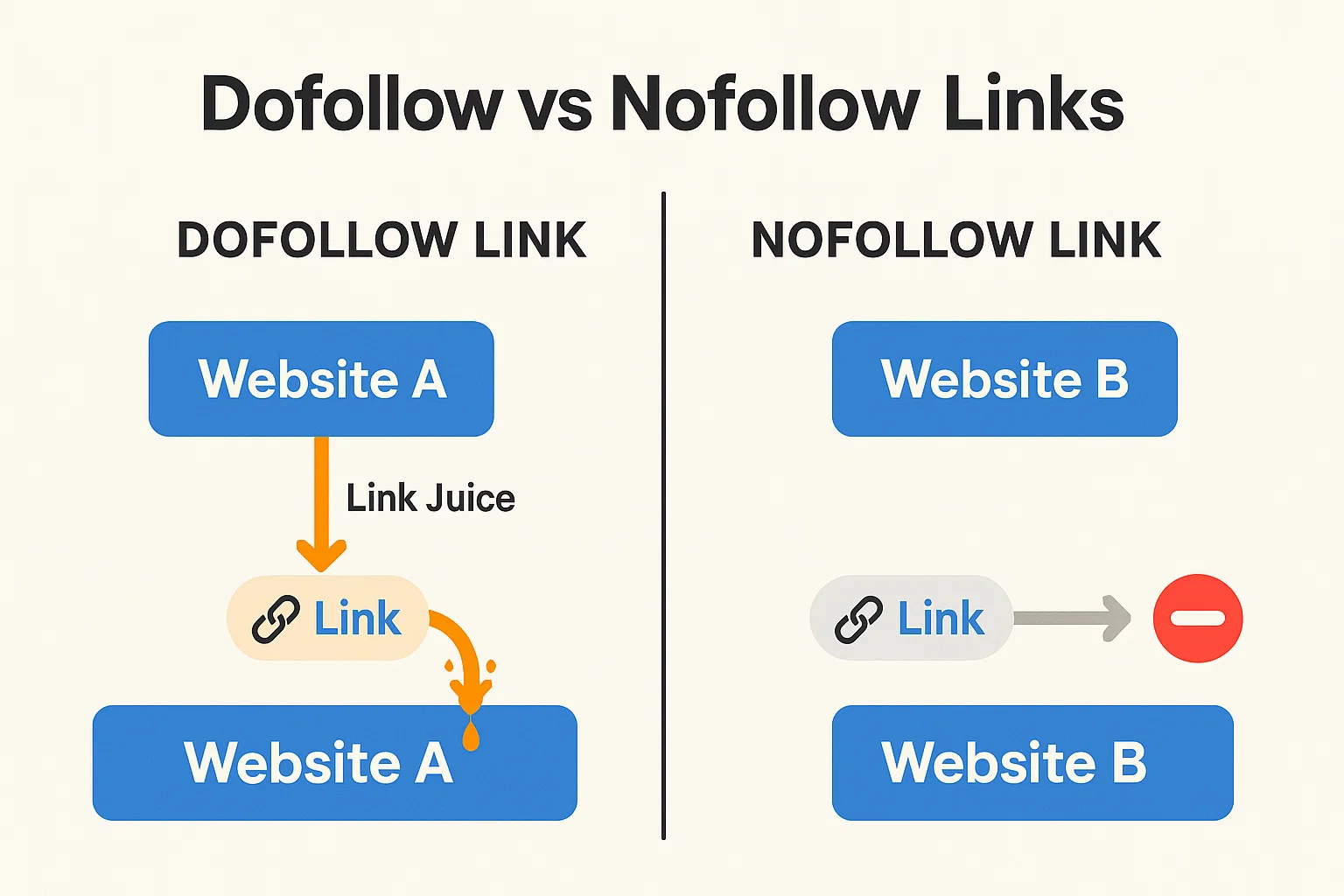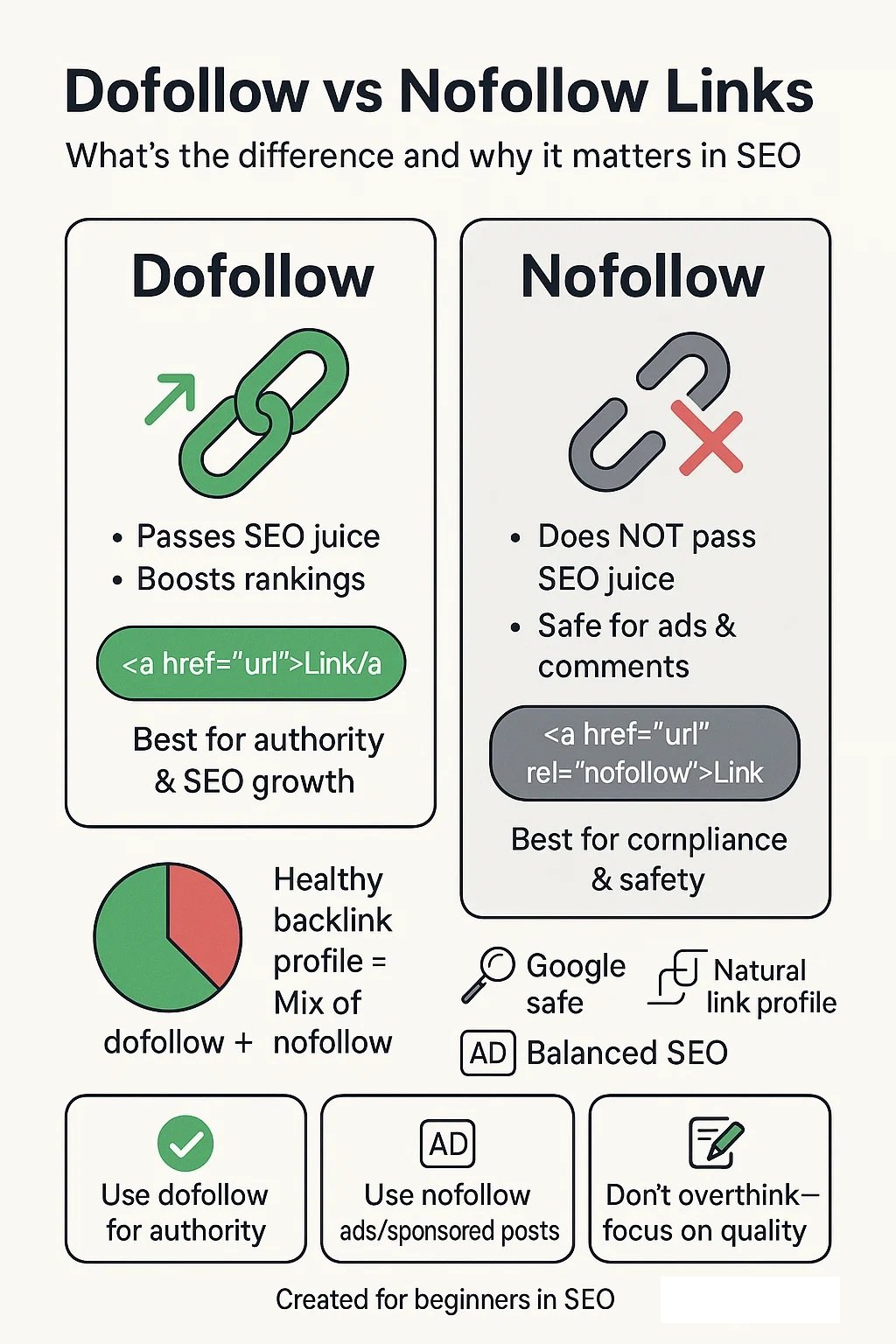
If those terms already sound intimidating, don’t worry, I’ll break it down in simple words. Think of dofollow links as a vote of confidence, while nofollow links are more like a “hey, I know this guy, but don’t hold me accountable for him”. Both have their place in the SEO universe, and understanding the difference can save you from wasted effort (and sometimes from Google penalties).
Why Links Matter in SEO
Imagine the internet as a giant city. Each website is like a shop or house, and links are the roads connecting them. The more quality roads leading to your place, the easier it is for people (and search engines) to find you.
But here’s the twist: not every road carries traffic. Some are busy highways (dofollow links), and some are more like side alleys (nofollow links). Both connect you, but only highways bring in that heavy flow of link juice, a fun SEO term that simply means “SEO value passed from one site to another.”
Google’s algorithm was practically built on this idea. Back in the early days, Larry Page and Sergey Brin invented PageRank, which literally ranked sites based on how many quality links they had pointing to them. Even though Google has evolved massively since then, links are still one of the top ranking factors.
Think about Wikipedia. Why do its pages dominate search results? Sure, it has lots of content. But it also has millions of links from other sites, acting like a never-ending stream of endorsements.
Without links, your site is an island. With the right links, it becomes part of the big city grid where everyone’s exchanging value.
What Is a Dofollow Link?
A dofollow link is the default type of link on the web. Unless you add something special to tell search engines otherwise, every link is automatically dofollow. That means when another site links to you, they’re saying:
“Hey Google, this website is worth checking out.”
That recommendation boosts your domain authority and rankings in search results.
Example of a dofollow link (HTML):
No extra tags, no fuss, Google follows this link and passes authority.
Real-world example:
Imagine a popular blog about digital marketing writes an article and links to your site as a “recommended tool.” That’s dofollow. And because that blog already has high authority, some of that power gets transferred to you.
For SEO, this is gold. That’s why link building is such a big deal in the SEO industry.
What Is a Nofollow Link?
A nofollow link is like a polite handshake without a business referral. It connects two sites, but tells search engines:
“Don’t count this as an endorsement.”
Websites often use nofollow links to avoid passing authority where it’s not safe or fair, like in blog comments, ads, or sponsored posts.
Example of a nofollow link (HTML):
See that rel=”nofollow”? That’s the instruction telling Google: follow the road, but don’t transfer SEO juice.
Case study – Wikipedia’s approach:
If you check any external link on Wikipedia, you’ll notice they’re all nofollow. Why? Because otherwise, spammers would be editing pages left and right to sneak in links for free SEO. Nofollow keeps Wikipedia’s credibility intact while still letting users click through for more info.
Key Difference Between Dofollow and Nofollow Links
Here’s the simplest breakdown:
| Feature | Dofollow Link | Nofollow Link |
|---|---|---|
| Passes link juice (SEO) | ✅ Yes | ❌ No |
| Default link type | ✅ Yes | ❌ No |
| Best for ranking boost | ✅ Definitely | ❌ Not really |
| Common use cases | Editorial links, guest posts, citations | Sponsored posts, ads, blog comments |
In short: dofollow = SEO power, nofollow = safe connections.

Why Would You Use a Nofollow Link?
Now you might be asking: “If nofollow doesn’t pass link juice, why bother?” Good question.
Here’s why:
Sponsored content compliance – Google hates paid links disguised as genuine recommendations. If you get paid for a link, you must use nofollow (or
rel="sponsored"). Otherwise, you risk penalties.Comment spam protection – Blogs and forums often drown in spammy links. Marking them nofollow keeps spammers from gaming the system.
Credibility filter – Maybe you mention a site for context but don’t want to vouch for it. Example: you’re writing about scam websites, you can link to them as nofollow to show readers, but not pass SEO juice.
So nofollow isn’t useless, it’s a guardrail.
Are LinkedIn Links Dofollow?
Sorry to burst your bubble, but LinkedIn links are usually nofollow. Same goes for most social media platforms like Twitter, Instagram, or Facebook.
Why? Imagine if every profile link passed link juice. SEOs would flood these sites with fake accounts just to get backlinks. Platforms know this trick and block it with nofollow.
But here’s the kicker: Social links still matter. A LinkedIn link may not give SEO juice, but it can drive real people to your site. Plus, appearing on a credible platform like LinkedIn builds trust.
So don’t ignore them, they’re part of your online presence, just not your SEO fuel.
Do Nofollow Links Help SEO at All?
Here’s where it gets interesting. Officially, nofollow links don’t pass link juice. But indirectly, they can:
Traffic boost – A nofollow link on Reddit or Quora can send thousands of visitors your way. Some of those visitors may link to you from their own blogs (with dofollow).
Brand awareness – The more people see your site mentioned, the more likely it is to get organic backlinks later.
Natural profile – Too many dofollow links without nofollows looks suspicious. Google expects a mix.
So yes, nofollow links can still help. They’re like unpaid marketing, they won’t rank you instantly but can spark opportunities.
What Is Link Juice, Really?
Think of link juice as energy points. When a powerful site links to you with a dofollow, you absorb some of its strength.
But here’s the catch: the more links on that page, the more diluted the juice. It’s like splitting a pizza, more people, smaller slices.
Example:
If a page has 1 dofollow link, you get the full pizza.
If it has 50 links, you get a tiny slice.
So while nofollow doesn’t share the pizza, dofollow links feed your SEO hunger.
Dofollow Link Generators & Caution
You’ve probably seen tools online promising “Free dofollow link generator!” Sounds tempting, right?
Bad news: most of them are shady. They drop your link on low-quality directories or spammy sites that may actually hurt your SEO. Google’s smart enough to ignore (or penalise) those tactics.
Case in point: In 2012, Google cracked down on link farms and unnatural link schemes. Sites that relied on those generators saw their rankings tank overnight.
Instead of chasing shortcuts, focus on:
Writing guest posts for reputable sites.
Creating unique content worth linking to.
Using tools like an AI Reword Tool or Spinbot Alternative to keep your writing fresh and plagiarism-free.
Best Practices for Using Both
So, how do you balance dofollow and nofollow links?
Aim for quality, not quantity – A single dofollow from Forbes beats 100 random blog directory links.
Use nofollow wisely – For ads, sponsored posts, or anything you don’t fully trust.
Mix it up – A natural backlink profile includes both types.
Don’t nofollow internal links – Linking between your own posts is safe and actually helps Google understand your site.
Think of it like a diet, you need a balance, not just sugar (dofollow) or just salad (nofollow).
Wrap-Up
At the end of the day, the difference between dofollow and nofollow links comes down to one thing: whether or not they pass authority. Dofollow links give you SEO fuel, while nofollow links keep things safe and balanced.
But don’t obsess over the labels too much. Focus on creating content people actually want to link to. When your work is valuable, both dofollow and nofollow links will naturally come your way.

Mia Creatives explores the intersection of technology and creativity. Dive into WordPress, SEO, and innovative ways to thrive online.